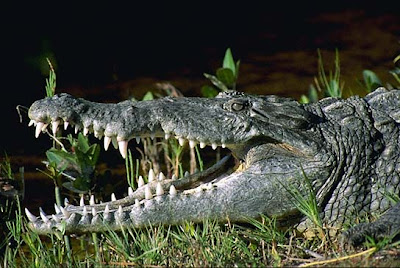Family: Crocodylidae, Crocodiles
Description 7-15' (2.1-4.6 m). Long slender snout distinguishes it from American Alligator. Gray-green, dark olive-green, or gray-brown with dark crossbands on back and tail; crossbands obscure in old adults. Large 4th tooth on bottom jaw visible when mouth is closed. No curved bony ridge in front of eyes, as seen in caimans.
Endangered Status The American Crocodile is on the U.S. Endangered Species List. It is classified as endangered throughout its range in southern Florida. Most of the world’s crocodilians -- 17 species out of a total of 22 -- are in danger of becoming extinct. All have suffered from collection by humans for their hides and the destruction of their habitat. The American Crocodile, declared endangered in 1975, lives only in southern Florida, where about 500 individuals survive. The species was nearly wiped out by the effects of the construction of highways, beachfront homes, and mobile home parks, as well as poaching. One of the current threats to the species is the increasing salinity of the waters in their habitat, a result of damming and other practices. The adult crocs can survive in salt water but their young cannot. Additionally, these very rare animals are sometimes killed by humans who mistake them for American Alligators, which are quite numerous and even considered a pest in some areas.
![]() Warning Crocodiles are carnivores that feed on fish and other large water animals and also stalk prey onshore near water. All crocodiles should be considered dangerous, even those basking in the sun. They can attack with amazing suddenness and have very sharp, grasping teeth and powerfully strong jaws.
Warning Crocodiles are carnivores that feed on fish and other large water animals and also stalk prey onshore near water. All crocodiles should be considered dangerous, even those basking in the sun. They can attack with amazing suddenness and have very sharp, grasping teeth and powerfully strong jaws.
Breeding Female builds mound-shaped nest of soil, sand, and mangrove peat; lays 35-50 eggs, late April to early May. Hatchlings emerge July to early August, are about 9" (22.9 cm) long.
Habitat Florida Bay in Everglades National Park, Biscayne Bay, and Florida Keys; bogs and mangrove swamps.
Range Extreme coastal s. Florida and the Keys.
Discussion May have reached 23' (7 m) in South America. The adult diet includes crabs, fish (especially mullet), raccoons, and water birds. Drawn to the sounds of hatchlings, the female opens the nest cavity and carefully picks up the young in her mouth and, in a series of trips, carries them to water.

0 comments
Post a Comment